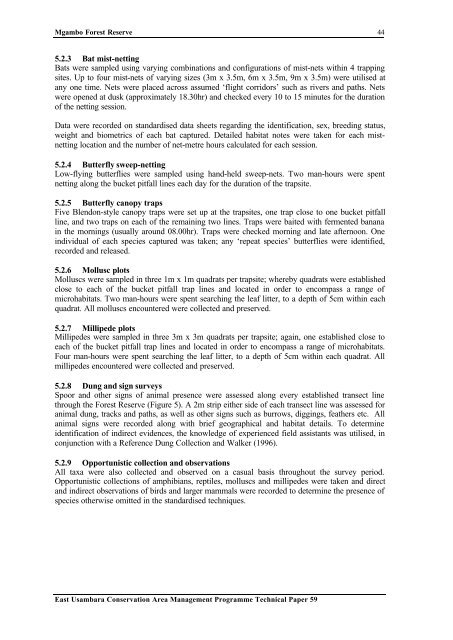Mgambo Forest Reserve: A biodiversity survey. - Eastern Arc ...
Mgambo Forest Reserve: A biodiversity survey. - Eastern Arc ...
Mgambo Forest Reserve: A biodiversity survey. - Eastern Arc ...
Create successful ePaper yourself
Turn your PDF publications into a flip-book with our unique Google optimized e-Paper software.
<strong>Mgambo</strong> <strong>Forest</strong> <strong>Reserve</strong><br />
44<br />
5.2.3 Bat mist-netting<br />
Bats were sampled using varying combinations and configurations of mist-nets within 4 trapping<br />
sites. Up to four mist-nets of varying sizes (3m x 3.5m, 6m x 3.5m, 9m x 3.5m) were utilised at<br />
any one time. Nets were placed across assumed ‘flight corridors’ such as rivers and paths. Nets<br />
were opened at dusk (approximately 18.30hr) and checked every 10 to 15 minutes for the duration<br />
of the netting session.<br />
Data were recorded on standardised data sheets regarding the identification, sex, breeding status,<br />
weight and biometrics of each bat captured. Detailed habitat notes were taken for each mistnetting<br />
location and the number of net-metre hours calculated for each session.<br />
5.2.4 Butterfly sweep-netting<br />
Low-flying butterflies were sampled using hand-held sweep-nets. Two man-hours were spent<br />
netting along the bucket pitfall lines each day for the duration of the trapsite.<br />
5.2.5 Butterfly canopy traps<br />
Five Blendon-style canopy traps were set up at the trapsites, one trap close to one bucket pitfall<br />
line, and two traps on each of the remaining two lines. Traps were baited with fermented banana<br />
in the mornings (usually around 08.00hr). Traps were checked morning and late afternoon. One<br />
individual of each species captured was taken; any ‘repeat species’ butterflies were identified,<br />
recorded and released.<br />
5.2.6 Mollusc plots<br />
Molluscs were sampled in three 1m x 1m quadrats per trapsite; whereby quadrats were established<br />
close to each of the bucket pitfall trap lines and located in order to encompass a range of<br />
microhabitats. Two man-hours were spent searching the leaf litter, to a depth of 5cm within each<br />
quadrat. All molluscs encountered were collected and preserved.<br />
5.2.7 Millipede plots<br />
Millipedes were sampled in three 3m x 3m quadrats per trapsite; again, one established close to<br />
each of the bucket pitfall trap lines and located in order to encompass a range of microhabitats.<br />
Four man-hours were spent searching the leaf litter, to a depth of 5cm within each quadrat. All<br />
millipedes encountered were collected and preserved.<br />
5.2.8 Dung and sign <strong>survey</strong>s<br />
Spoor and other signs of animal presence were assessed along every established transect line<br />
through the <strong>Forest</strong> <strong>Reserve</strong> (Figure 5). A 2m strip either side of each transect line was assessed for<br />
animal dung, tracks and paths, as well as other signs such as burrows, diggings, feathers etc. All<br />
animal signs were recorded along with brief geographical and habitat details. To determine<br />
identification of indirect evidences, the knowledge of experienced field assistants was utilised, in<br />
conjunction with a Reference Dung Collection and Walker (1996).<br />
5.2.9 Opportunistic collection and observations<br />
All taxa were also collected and observed on a casual basis throughout the <strong>survey</strong> period.<br />
Opportunistic collections of amphibians, reptiles, molluscs and millipedes were taken and direct<br />
and indirect observations of birds and larger mammals were recorded to determine the presence of<br />
species otherwise omitted in the standardised techniques.<br />
East Usambara Conservation Area Management Programme Technical Paper 59
















